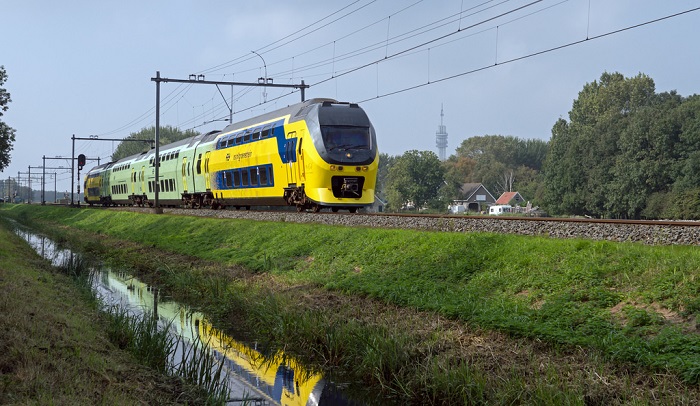Wind-Powered Trains: A Green Solution For Sustainable Transport

Table of Contents
How Wind-Powered Trains Work
Harnessing wind energy for trains involves several technological approaches. The most straightforward method utilizes wind turbines to generate electricity, directly powering the train's electric motor. This approach leverages existing renewable energy infrastructure and technology. Alternatively, wind-assisted propulsion systems can reduce energy consumption by using the kinetic energy of the wind to augment the train's movement. This approach is particularly promising for reducing the energy demands of existing rail lines.
- Direct wind turbine power generation: Wind turbines located strategically along the railway line generate electricity that feeds directly into the train's electric motor, providing a clean and sustainable power source. This method requires robust energy storage solutions to address the intermittency of wind power.
- Wind-assisted propulsion systems: These systems use strategically placed wind catchers or sails to harness wind energy, thereby reducing the amount of energy needed from the train's primary power source, whether electric or diesel. This is a more passive approach, offering supplemental power.
- Hybrid systems: Combining wind power with other renewable energy sources, such as solar panels on the train or along the tracks, creates a more reliable and consistent energy supply, mitigating the variability inherent in wind power alone. This approach maximizes the utilization of renewable energy sources.
- Energy storage solutions: Advanced battery technologies are crucial for wind-powered trains. They store excess energy generated during periods of high wind speed for use when wind conditions are less favorable, ensuring a continuous power supply for the train's operation. This is crucial for reliable service.
The efficiency of each approach depends on factors such as wind speed consistency, geographical location, and technological advancements in renewable energy harvesting and storage. While limitations exist, ongoing research and development in green technology continuously improve the feasibility and effectiveness of these systems.
Environmental Benefits of Wind-Powered Trains
The environmental advantages of wind-powered trains are substantial, offering a significant improvement over traditional fossil fuel-dependent trains. The shift to wind power results in a drastic reduction in environmental impact, contributing to a healthier planet.
- Significant decrease in greenhouse gas emissions: Replacing fossil fuels with wind energy dramatically reduces the carbon footprint of railway transportation, mitigating climate change and its harmful effects.
- Reduced reliance on fossil fuels: Wind-powered trains significantly lessen our dependence on finite and polluting fossil fuels, promoting energy independence and security.
- Lower air and noise pollution: Wind-powered trains produce minimal air and noise pollution compared to diesel or even electric trains powered by non-renewable sources, leading to improved air quality along railway lines and in nearby communities. This improves public health and reduces environmental damage.
- Positive impact on air quality near railway lines: Reduced emissions translate directly to cleaner air for communities situated near railway tracks, improving public health and quality of life.
Studies show that wind-powered trains can significantly reduce greenhouse gas emissions by up to 90% compared to conventional diesel trains, making them a powerful tool in the fight against climate change. This eco-friendly transport option is essential for a sustainable future.
Economic Aspects of Wind-Powered Trains
While the initial investment costs for wind-powered train infrastructure are high, the long-term economic benefits are significant and worthy of consideration. The transition to wind power will initially require investment but ultimately leads to sustainable cost savings.
- High upfront costs for infrastructure development: Establishing the necessary wind turbine infrastructure along railway lines represents a substantial initial investment. This includes turbine installation, grid connection, and energy storage facilities.
- Potential for long-term cost savings through reduced fuel consumption: Over time, the reduced reliance on fossil fuels translates to significant cost savings, as wind energy is essentially free after the initial investment. This leads to lower operating costs over the lifetime of the railway system.
- Government incentives and subsidies for green technologies: Many governments offer financial incentives and subsidies to promote the adoption of green technologies, including wind energy in transportation. These incentives can make wind-powered trains more economically viable.
- Economic benefits from job creation in the renewable energy sector: The development and maintenance of wind-powered train systems create jobs in the renewable energy sector, stimulating economic growth and supporting a transition to a green economy.
The long-term economic viability and potential return on investment are promising, making wind-powered trains a sustainable and potentially cost-effective solution for railway transportation. The cost-effectiveness is likely to improve with technological advancements and economies of scale.
Challenges and Future Prospects of Wind-Powered Trains
Despite the significant potential of wind-powered trains, several challenges need to be addressed to facilitate widespread adoption. These challenges are surmountable with further research and development.
- Intermittency of wind energy: Wind energy is intermittent, requiring effective energy storage solutions to ensure a continuous power supply for train operations. Advanced battery technology and smart grid management are key to addressing this.
- Land requirements for wind turbines along railway lines: Installing wind turbines along railway lines requires land, which might present logistical and environmental challenges in certain areas. Careful planning and innovative turbine designs are needed to minimize land use impact.
- Integration with existing railway infrastructure: Integrating wind-powered systems into existing railway networks requires careful planning and modification of existing infrastructure, posing a significant challenge. Retrofitting existing systems will require a phased approach.
- Technological advancements needed to optimize efficiency: Continued research and development are crucial to improve the efficiency and reliability of wind-powered train technologies, reducing costs and maximizing performance. Innovation is key to realizing the full potential of this technology.
Future research and development should focus on improving energy storage technologies, optimizing wind turbine design for railway applications, and developing efficient integration strategies with existing infrastructure. Technological innovation is paramount for the widespread adoption of wind-powered trains.
Conclusion
Wind-powered trains offer a compelling solution for sustainable and environmentally friendly transportation. Their significant reduction in carbon footprint, lower air and noise pollution, and long-term economic benefits make them an attractive alternative to traditional railway systems. While challenges remain, particularly concerning the intermittency of wind energy and integration with existing infrastructure, ongoing research and development are paving the way for a future where wind-powered trains contribute significantly to a greener and more sustainable transportation sector. Join the movement towards sustainable transportation by learning more about the exciting potential of wind-powered trains. Let's pave the way for a greener future!

Featured Posts
-
 Kendal Pitch Tragedy Manchester United Honors Young Fan Poppy Atkinson
May 03, 2025
Kendal Pitch Tragedy Manchester United Honors Young Fan Poppy Atkinson
May 03, 2025 -
 Fortnite Cowboy Bebop Collaboration Offers Free In Game Items
May 03, 2025
Fortnite Cowboy Bebop Collaboration Offers Free In Game Items
May 03, 2025 -
 Vatican Trump Et Macron Une Rencontre Tendue
May 03, 2025
Vatican Trump Et Macron Une Rencontre Tendue
May 03, 2025 -
 Maine Launches First Ever Post Election Audit Pilot Program
May 03, 2025
Maine Launches First Ever Post Election Audit Pilot Program
May 03, 2025 -
 Arsenals Havertz No Improvement Says Souness
May 03, 2025
Arsenals Havertz No Improvement Says Souness
May 03, 2025
